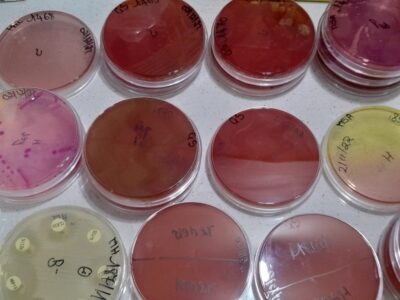Main content
Abstract
In 2012 the discovery of the Middle East respiratory syndrome coronavirus and the subsequent emergence of Middle East respiratory syndrome (MERS) were reported. Since then almost 1000 cases have been diagnosed, in several countries all within, or related to travel from, the Middle East. Apart from dromedary camel-to-human transmission, nosocomial and within family transmission have been reported. The estimated case fatality rate in diagnosed cases of approximately 40%, and the so far limited human-to-human transmission, warrant a global response. This should include active monitoring of the extent and origins of the ongoing epidemic as well as the development and implementation of preventive and therapeutic intervention strategies.
Introduction
In 2012 the New England Journal of Medicine reported the isolation and identification of a novel coronavirus from a patient who had died with severe pneumonia and renal failure [1]. The patient presented with fever, cough and shortness of breath and 11 days after admission to a private hospital in Jeddah, Saudi Arabia, he died from progressive respiratory failure. Isolation and characterization of the causative agent, MERS coronavirus (MERS-CoV), resulted from a collaborative effort between Dr Zaki, the treating physician involved, and the department of Viroscience of Erasmus Medical Center in Rotterdam. Retrospective studies have later traced this case back to a cluster of 11 patients (including 10 health care workers) with severe lower respiratory tract infection admitted to an intensive care unit in Zarga, Jordan, in March & April 2012 [2]. The second patient diagnosed with MERS-CoV infection was a patient from Qatar who had been transported to the United Kingdom for intensive care treatment [3]. Genetic analysis of the viruses from both patients revealed an almost 100% homology, which resulted in the beginning of the monitoring of the ongoing MERS epidemic.
Virology & SARS
MERS-CoV, as the name suggests, belongs to the coronavirus family, which is a large group of single stranded RNA viruses that may cause a variety of diseases in animals, whereas some members may cause relatively mild upper respiratory tract infections in humans [4]. MERS-CoV was first discovered using a pan-coronavirus reverse transcription- polymerase chain reaction (RT-PCR) assay. Phylogenetic analysis showed that MERS-CoV belongs to subgroup 2c of the lineage Betacoronavirus [5]. Two of the five currently known human coronaviruses (CoV-OC43 and CoV-229E) cause relatively mild upper respiratory infections or common colds in humans. Another recently discovered human coronavirus may cause more serious respiratory infections especially in young children. In 2003 SARS-coronavirus (SARS-CoV) was discovered as the cause of the first emerging pandemic of the 21st century: severe acute respiratory syndrome (SARS). Within months after its emergence in Guangdong Province in mainland China, SARS-CoV had infected over 8000 individuals with a case fatality rate of approximately 10% and a total spread over 26 countries on five continents, putting emphasis on the emerging potential of coronaviruses [6]. Although the reservoir of SARS-CoV was found in bats, several carnivore species, like civet cats sold for human consumption on live animal markets, were intermediate hosts that allowed animal-to-human transmission [7]. An extensive collaborative international effort coordinated by World Health Organization (WHO), resulted in early containment of what could have be a large pandemic.
Epidemiology and the current outbreak
According to the latest ProMed reports almost 1000 laboratory confirmed cases of MERS-CoV have been reported to the WHO, including at least 209 deaths (case fatality rate of approximately 40%). For the current outbreak the affected countries in the Middle East include Iran, Jordan, Kuwait, Lebanon, Oman, Qatar, Saudi Arabia, United Arab Emirates and Yemen. The largest number of infections occurred in Saudi Arabia [8]. Furthermore, import cases have been reported from countries in Africa, Europe, Asia and the United States of America. Analysis of local (often small) outbreaks of MERS-CoV revealed several unique epidemiological characteristics of this disease. In the beginning of the pandemic a strong predominance for male patients was notified with a male to female ration up to 3.3:1. In following MERS-CoV outbreak studies this ratio decreased with a slightly increased number of males being infected compared to females [9]. Overall 63.5% of infections reported to the WHO are male with a median age of 47 years [8]. Furthermore, there is a strong suggestion that seasonality plays a role in MERS-CoV infection incidence since during spring time in the Middle East highest infection rates were reported in 2012 and 2013 [10].
Zoonotic transmission
Of all cases reported to the WHO only 1 in 4 is currently considered a primary case, the result of direct zoonotic transmission from animal to human [10]. Recently, studies from several groups point to dromedary camels as the MERS-CoV (intermediate) reservoir. The virus has been isolated from dromedary camels, and genomic analyses show that MERS-CoVs in dromedary camels are virtually identical to those identified in humans [11,12]. Furthermore, serological surveys show a high number of seropositive dromedary camels, originating from multiple countries, also outside of the Middle East [10,13]. The exact route of transmission from dromedary camels to humans remains unknown, but preliminary results from experimental studies and RT-PCR detection in respiratory tissues and camel milk suggest that respiratory secretions and milk from infected dromedary camels play a role [14]. In contrast to humans, MERSCoV has been detected in the upper respiratory tract, making direct aerosol transmission to humans also a good possibility [15]. This is further confirmed by the detection of MERS-CoV in air samples from a camel barn owned by an infected patient [16]. As was the case for SARS-coronavirus, an intermediate host most likely resulted in the animal to human transmission. Dromedary camels most likely acquired MERS-CoV from reservoir bats (exact species yet unknown) and the virus apparently has spread efficiently within dromedary camel populations [7].
Human-to-human transmission
Human-to-human transmission of MERS-CoV occurs often clustered within family settings and in hospitals. Multiple infection clusters have been reported in families living closely together with an average of secondary cases originated from the index case varying between 10 and 20% of the exposed group [10]. Furthermore, the importance of human-to-human transmission in MERS-CoV outbreaks is emphasized by the high number of health care related outbreaks, for instance in Saudi Arabia more than 25% of the reported cases are health care workers [8,17]. Risk analysis of health care related outbreaks revealed that infected personnel often were involved in aerosol generating procedures such as intubation, airway suctioning, and sputum induction [9]. Based on the analysis of the patterns of spread of MERS-CoV among family clusters or health care related outbreaks there is a strong suggestion that transmission occurs through droplets or physical contacts [7].
Symptoms and signs
MERS-CoV infection clinically presents itself as a typical severe respiratory infection. Typical symptoms include fever, cough and breathing difficulties, myalgia, nausea, vomiting and diarrhoea [18]. Furthermore, as was the case for the index patient in 2012, renal failure is documented in many MERSCoV patients. However, thus far it is unknown if renal insufficiency is the result of treatment and hypoxia or directly associated with MERS-CoV infection. Recently the identification of apparently asymptomatic cases has increased and in Saudi Arabia, where the largest numbers of cases were registered, almost 30% of confirmed cases only reported asymptomatic to mild disease [8].
Diagnosis
According to the WHO guidance, patients should be tested for MERS-CoV infection if they develop pneumonia or pneumonitis and fever with a history of travel to or residence in the Arabian Peninsula in the 14 days before disease onset; or in case of known contact with a known confirmed or suspected MERS case [19]. According to the MERS case definition a confirmed case requires a positive RT-PCR test on at least two specific genomic targets or a single positive target accompanied by sequence analysis [19]. Cases with only one single RT-PCR positive test are considered probable MERS-CoV cases. Samples with the highest viral load, and thereby most suitable for RT-PCR detection, are those taken from the lower respiratory tract. However, oronasal swabs can also be used in the acute phase of the disease [9]. Commercially available serological assays can especially be of use in analysis of cluster outbreaks and the detection of asymptomatic secondary cases. However, no official recommendations are currently available regarding serological tests, and validation has been difficult because of limited availability of human convalescent sera [9,19].
Conclusion
Until now almost 1000 MERS cases have been reported with a case fatality rate of approximately 40%. All these cases have occurred either within, or travelling from Middle East countries. MERS-CoV infection causes clinical symptoms mainly related to acute respiratory distress. Although the source of the emerging epidemic can probably be traced back to contacts with dromedary camels as the intermediate host species, family clusters and health care related outbreaks indicate that human-to-human transmission is also significant. Although the number of persons infected by SARS-CoV was higher compared to those currently affected by MERS-CoV infection, the SARS outbreak was rapidly controlled whereas MERS-CoV is still spreading two years after its discovery. With about 1 out of every 4 cases being direct zoonotic infections there is an ongoing need for strengthening infection control measures among humans in order to prevent further adaptation of MERS-CoV to its novel human host.
References
- Zaki AM, van Boheemen S, Bestebroer TM, et al. Isolation of a novel coronavirus from a man with pneumonia in Saudi Arabia. N Engl J Med. 2012 Nov 8;367(19):1814-20. doi: 10.1056/NEJMoa1211721 [doi].
- Hijawi B, Abdallat M, Sayaydeh A, et al. Novel coronavirus infections in Jordan, April 2012: epidemiological findings from a retrospective investigation. East Mediterr Health J. 2013;19 Suppl 1:S12-S18.
- Bermingham A, Chand MA, Brown CS, et al. Severe respiratory illness caused by a novel coronavirus, in a patient transferred to the United Kingdom from the Middle East, September 2012. Euro Surveill. 2012;17(40):20290.
- Lu R, Yu X, Wang W, et al. Characterization of human coronavirus etiology in Chinese adults with acute upper respiratory tract infection by real-time RT-PCR assays. PLoS One. 2012;7(6):e38638. doi: 10.1371/journal.pone.0038638 [doi]; PONE-D-12-04432 [pii]. Pubmed PMID: PMC3376151.
- van Boheemen S, de Graaf M, Lauber C, et al. Genomic characterization of a newly discovered coronavirus associated with acute respiratory distress syndrome in humans. MBio. 2012;3(6) doi: mBio.00473-12 [pii];10.1128/mBio.00473-12 [doi]. Pubmed PMID: PMC3509437.
- Peiris JS, Yuen KY, Osterhaus AD, et al. The severe acute respiratory syndrome. N Engl J Med. 2003 Dec 18:349(25):2431-41. doi: 10.1056/NEJMra032498 [doi];349/25/2431 [pii].
- Raj VS, Osterhaus AD, Fouchier RA, et al. MERS: emergence of a novel human coronavirus. Curr Opin Virol. 2014 Apr;5:58-62. doi: S1879-6257(14)00011-X [pii];10.1016/j.coviro.2014.01.010 [doi]. Pubmed PMID: PMC4028407.
- WHO. Middle East respiratory syndrome coronavirus (MERS-CoV) summary and literature update-as of 11 June 2014. 2014 Jun 11.
- Al-Tawfiq JA, Memish ZA. Middle East respiratory syndrome coronavirus: epidemiology and disease control measures. Infect Drug Resist. 2014;7:281-7. doi: 10.2147/IDR.S51283 [doi];idr-7-281 [pii]. Pubmed PMID: PMC4226520.
- Raj VS, Farag EA, Reusken CB, et al. Isolation of MERS coronavirus from a dromedary camel, Qatar, 2014. Emerg Infect Dis. 2014 Aug;20(8):1339-42. doi: 10.3201/eid2008.140663 [doi]. Pubmed PMID: PMC4111206.
- Reusken CB, Messadi L, Feyisa A, et al. Geographic distribution of MERS coronavirus among dromedary camels, Africa. Emerg Infect Dis. 2014 Aug;20(8):1370-4. doi: 10.3201/eid2008.140590 [doi]. Pubmed PMID: PMC4111168.
- Reusken CB, Haagmans BL, Muller MA, et al. Middle East respiratory syndrome coronavirus neutralising serum antibodies in dromedary camels: a comparative serological study. Lancet Infect Dis. 2013 Oct;13(10):859-66. doi: S1473-3099(13)70164-6 [pii];10.1016/S1473-3099(13)70164-6 [doi].
- Reusken CB, Farag EA, Jonges M, et al. Middle East respiratory syndrome coronavirus (MERS-CoV) RNA and neutralising antibodies in milk collected according to local customs from dromedary camels, Qatar, April 2014. Euro Surveill. 2014;19 (23).
- Adney DR, van Doremalen N, Brown VR, et al. Replication and shedding of MERS-CoV in upper respiratory tract of inoculated dromedary camels. Emerg Infect Dis. 2014 Dec;20(12):1999-2005. doi: 10.3201/eid2012.141280 [doi]. Pubmed PMID: PMC4257817.
- Azhar EI, Hashem AM, El-Kafrawy SA, et al. Detection of the Middle East respiratory syndrome coronavirus genome in an air sample originating from a camel barn owned by an infected patient. MBio. 2014;5(4):e01450-14. doi: mBio.01450-14 [pii];10.1128/mBio.01450-14 [doi]. Pubmed PMID: PMC4120199.



















































